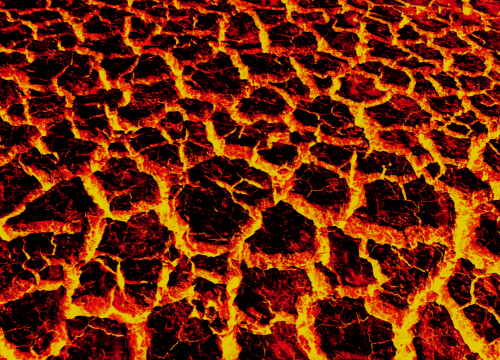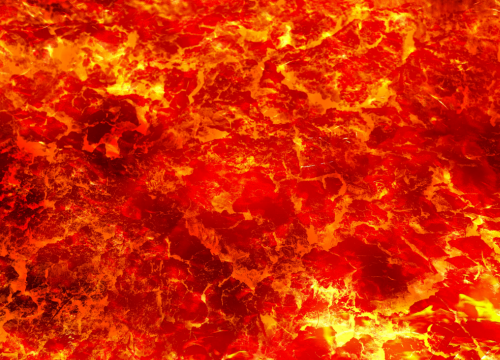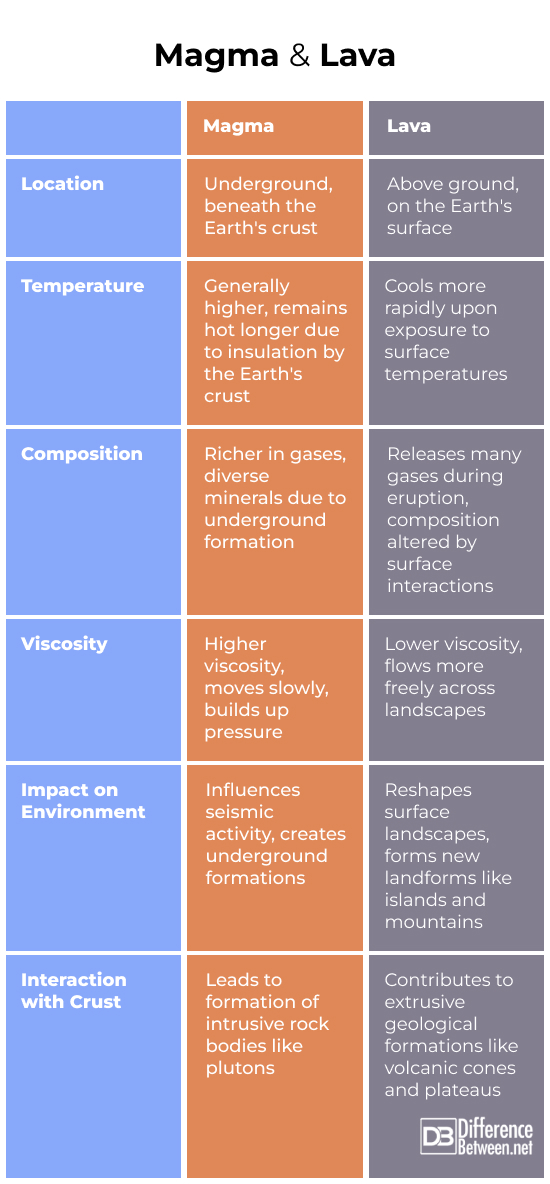Introduction
Discover how magma and lava, two of the nature’s greatest forces, built our planet underneath and above the surface. Lava and magma are more than liquid rock. Magma is under the surface, and lava flows. The designs incorporate mountains, new nations, and landscapes.
This magma-lava adventure is more than a rock and fire narrative. It depicts Earth’s genesis and development. From the heated depths to the wide sky, magma and lava depict how Earth was built over thousands of years.
Investigating the parallels and contrasts between these two natural occurrences teaches us not just about science but also about our world. The geology of Earth teaches us about the inner workings of our dynamic planet via its many processes, from the gradual, steady creation of magma to the loud, dramatic explosion of lava.
Learn about magma and lava and how they form Earth’s gorgeous geology in distinct but linked ways.

What’s Magma?
Definition and Form
Imagine magma stirring in the Earth’s mysterious underbelly. Molten rock, a violent mixture of minerals and gasses, develops in central Earth. It comes from the mantle and crust’s high heat, which melts rock. Radioactive decay, tectonic friction, and the Earth’s interior heat create magma in this high-pressure, high-temperature melting.
Key traits
Magma is more than heated liquid rock. Complex and energetic, it heats between 700°C and 1300°C. The consistency? Imagine honey millions of times thicker. Silica content determines magma thickness, or viscosity. It’s a simmering cauldron full with water vapor, carbon dioxide, and sulfur eager to escape.
Earth Geology Role
Magma shapes our planet’s surface from underground. When it cools and hardens, it creates several igneous rocks that describe its fiery beginnings. But magma’s impact goes beyond rock creation. It powers spectacular volcanic mountains and strange plutons. Earth’s geology changes due to magma’s movements and eruptions.

What’s Lava?
Definition and Form
Imagine magma, that hot, restless liquid beneath the Earth’s crust, erupting. That’s lava. Volcanic explosions release magma, creating lava. Leaving high-pressure subterranean existence for Earth’s free air is a fantastic release. Geological factors including tectonic plate movements, volcanic activity, and gasses seeking escape propel it from the depths to the surface.
Key traits
Magma’s alter ego, lava, has a distinct identity. After hitting the surface, its 700°C to 1200°C temperature drops. Even as it cools, it flows, sometimes slowly like a thick river, sometimes quickly. This phenomenon is due to its silica content. High-silica lava is thick and sluggish, whereas low-silica is fluid and rapid. Next, the spectacle: shimmering rivers of fire at night, steaming, hardening trails throughout the day.
Earth Geology Role
Lava creates and destroys as it flows across Earth. It solidifies into various rocks when it cools. Basaltic lava flows can form vast plateaus or ocean islands, while slower, thicker lava can form spectacular volcanoes. Lava’s touch may be harsh. It may completely change landscapes, sometimes at tremendous cost to ecosystems and human communities. However, lava may enhance soils and allow fresh life. Lava creates and changes landscapes in Earth’s geological cycle.
Similarities Between Lava and Magma
Magma and lava have several basic traits despite their differences. They’re like siblings, sprung from the Earth’s fiery heart but taking separate paths.
Born of Molten Rock
Molten rock is the source of magma and lava. This shared genesis tale begins in the Earth’s mantle or crust, where high heat and pressure dissolve rock. This continual cycle of creation and destruction under our feet is as ancient as the Earth.
The presence of minerals and gases
Magma and lava are complicated mineral and gas mixtures. They disintegrate and convey Earth’s inner materials as they develop. This mixture contains silica, iron, water vapor, carbon dioxide, and sulfur. These components dictate their properties and shape their eruptions and rock formations.
Impact on Earth’s Landscape
Magma and lava shape Earth’s geography. Underground magma may generate mountains, push up landmasses, and create crust. Lava, however, takes control at the surface. It flows, solidifies, and forms volcanoes, islands, and fertile plains. Like painters, they continuously reshape our globe in their own manner.
Key Differences Between Magma and Lava
Magma and lava are brothers in their fiery start, yet their trajectories vary, defining their roles in Earth’s geology.
Underground magma vs. above-ground lava
Location is the main difference between magma and lava. Hidden chambers and channels under the Earth’s surface contain magma, which controls its interior dynamics. Lava, on the other hand, is magma’s spectacular appearance on Earth and interacts with the air and terrain.
Temperature: Heating and cooling variations
Their differences depend on temperature. The Earth’s crust keeps magma warmer for longer. This continuous heat permits complicated chemical reactions and mineral forms. Lava cools faster at the surface, resulting in faster solidification and distinct rock textures.
Variations in Mineral Content
Both magma and lava are molten rock, although their constituents differ. Due to its deep genesis, magma may contain more volatile gasses and minerals. Many gases generated during eruption and surface interactions can change the mineral content of lava.
Viscosity Changes Movement and Flow
Flow resistance, or viscosity, is another difference. Silica concentration and deep pressure make magma more viscous, slowing it down and allowing it to accumulate pressure. Lava flows more readily after eruption because it loses gas and silica.
Environmental Impact: How They Shape Earth
Lava and magma form Earth differently. Magma pressure may build subsurface landforms and generate earthquakes, volcanoes. Lava forms new landscapes and ecosystems when it flows across land. Lava flows provide rich soils and change ecosystems.
Their Role in Geological Formations with the Crust
Magma and lava interact differently with Earth’s crust. Slow-moving magma may build plutons and batholiths, altering the Earth from inside. Lava forms volcanic mountains, lava domes, and plateaus, molding Earth’s surface more visibly.
Magma Vs Lava

Summary
We have discovered the distinct but connected roles that lava and magma play in shaping our planet through this exploration of these two geological processes. Even though you can’t see it, magma is a powerful force below the Earth’s surface. Lava, on the other hand, is a visible and active form of magma. Both come from molten rock, but their paths, properties, and effects on the Earth are different.
Earthquakes and intrusive rock formations are produced by the movement and transformation of magma beneath the surface of the Earth. If, on the other hand, lava comes to the top of the Earth, it changes the ecosystems and changes the shape of the land. Geographical differences, temperature, chemical make-up, viscosity, and touch with the Earth’s crust show how complex and changing our planet’s geology is.
FAQs
At what point does magma become lava?
When magma travels through fissures or eruptions to the Earth’s surface, it turns into lava. Changes in composition and temperature result from the release of gases and pressure during the transition.
Which cools faster lava or magma?
Magma cools more slowly than lava. Lava is exposed to colder temperatures when it reaches the Earth’s surface, which causes it to harden quickly. Cooling considerably more slowly beneath is magma.
Are all rocks made from lava?
Not every rock is formed of lava. Igneous rocks are generated by the eruption of lava; other types of rocks include sedimentary and metamorphic rocks, which are created when heat and pressure cause preexisting rock types to change.
What is solidified lava called?
Igneous rock is defined as cooled lava. The precise term is determined on the composition and cooling circumstances; basalt, for instance, is a typical form of lava that has crystallized.
Is pumice lava rock?
Indeed, one kind of lava rock is pumice. It is formed by rapidly cooling, gas-rich lava that becomes a porous, light rock.
Can you touch lava?
Lava may burn badly and is very dangerous to touch because of its high temperature. Even at its coolest, lava can reach temperatures of 700°C.
Is Mount Everest a volcano?
No, a volcano is not what Mount Everest is. It is a mountain that was created by the Indian and Eurasian plates colliding and rising together.
What if a drop of lava fell on you?
Because of its intense heat, a drop of lava falling on you would burn you severely. The precise impact would probably cause serious harm, depending on the lava’s temperature and the length of contact.
- Difference Between Suicide and Euthanasia - May 22, 2024
- Difference Between Vitamin D and Vitamin D3 - May 21, 2024
- Difference Between Running Shoes and Walking Shoes - April 30, 2024


heeeeeeeeeeeeeeeeeeeeeeeeeeeeeeeeeeey im bored
Reply
The author of this article not only writes like a crusty pair of socks, but is completely and utterly wrong about the difference between magma and lava. The difference is actually much simpler than all this other gibberish: Magma is molten rock that is underground, lava is molten rock that has come out from underground. That’s it, kids. Nothing more to it.
Reply